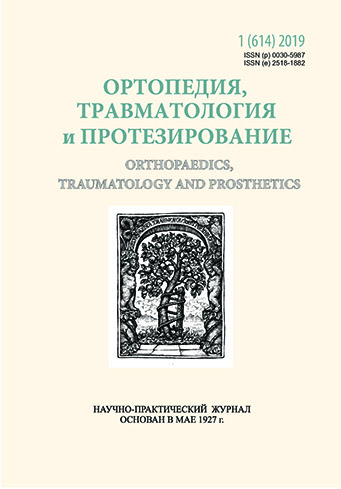Sling therapy as a means of improving the motor ability of children with spastic paraparesis
DOI:
https://doi.org/10.15674/0030-59872019191-95Keywords:
sling therapy, cerebral palsyAbstract
The high prevalence of cerebral palsy in the world encourages specialists to look for new methods of rehabilitation, one of which is sling therapy using passive suspension systems of various designs.
Objective: to evaluate the effectiveness of sling therapy in the complex rehabilitation of children with spastic paraparesis due to cerebral palsy.
Methods: two groups of children were included into the study, they were matched by sex and age. The rehabilitation course of the main group (22 patients) included the method of sling-therapy. The control group (20 children) underwent a rehabilitation course without passive suspension systems. The effectiveness of the rehabilitation process was evaluated using the GMFCS classification (Gross Motor Function Classification System), scale GMFM (Gross Motor Function Measure), Ashworth test (Modified Ashworth scale), the coefficient of weight loading, oscillations in the total pressure center, and estimates of the amount of energy expenditure of the patient during movement (Рhysical Сost Іndex, PCI).
Results: after the rehabilitation course the degree of motor abilities increased in children of the main group on average by 23 %, in the control group — by 12 %. The average value of the coefficient of weight bearing in children of the main group increased by 0.29; in control — by 0.08. The average value of oscillations of the total pressure center decreased at selfstanding in the main group by 10 mm, in the control group — by 3 mm; energy movement index for movement — by 8 and 2 units, respectively.
Conclusions: the method of gravitational neuromuscular activation using a passive suspension system in children with lower spastic paraparesis due to cerebral palsy allows strengthening of weakened and relaxing of spasmodic muscles, improving the stabilizing function of the limbs and body, to improve the stereotype of support and walking. This makes it possible to recommend this method for the practical work of rehabilitation centers.
References
- Kapandji, I. A. (1982). The Physiology of the Joints: Lower limb. Edinburgh: Churchill Livingstone.
- Bergmark, A. (1989). Stability of the lumbar spine. Acta Orthopaedica Scandinavica, 60 (Suppl. 230), 1–54. doi: 10.3109/17453678909154177
- Solodyankin, E. E., Burmistrov, A. L., Bondareva, E. A. & Mozol, V. V. (2014). Neuromuscular activation with the use of suspension systems in the rehabilitation of patients. Medical News, 11, 53–55. (In Russian)
- Retrieved from http://funbody.ru/publication/5001/
- Esengaraeva, S. D., Abildinova, D. K. & Abildinov D. R. Neuromuscular activation — a review of rehabilitation methods. Retrieved from https://nmaktiv.nethouse.ru/articles/115689. (In Russian)
- Boyko, V. V., Lisoviy, V. M., Makarov, V. V. & [et al.]. (2018). Lectures of the Polish-Polish. Kharkiv: NTMT.
- Katzki, D., & Müller, M. (1999). Schlingentisch. Elsevier, Urban&Fischer Verlag.
- Starikov, S. M., Rusakevich, A. P., & Annushkin, A. D. (2010). Use of visual self-control during locomotor exercises. Sochi.
- Kochetkov, A. V., Pryanikov, I. V., Kostiv, I. M. & [et al.]. (2009). Method of restoring lost or impaired walking function using the Lokomat robotic system (Nosoma, Switzerland) in patients with traumatic spinal cord disease (medical technology). Bulletin of restorative medicine, 2 (30), 95–99. (In Russian)
- Starikov, S. M. (2011). Neuromuscular activation — a modern approach. Bulletin of restorative medicine, 4 (44),22–26. (In Russian)
- Semenova, K. A. (2007). Rehabilitation treatment of children with perinatal lesions of the nervous system and with cerebral palsy. Moscow: Law and Order. (In Russian)
- Unified clinical protocol for medical aid and medical rehabilitation «Cerebral palsy and other organic brain lesions in children accompanied by motor disorders» [Electronic resource]. Ministry of Health of Ukraine. Retrieved from http:// mtd.dec.gov.ua/images/dodatki/2013_286/2013_286ykpmd_tserparal_dity.pdf. (in Ukrainian)
- Palisano, R., Rosenbaum, P., Walter, S., Russell, D., Wood, E., & Galuppi, B. (2008). Gross Motor Function Classification System for Cerebral Palsy (GMFCS). Developmental Medicine & Child Neurology, 39 (4), 214–223. doi: 10.1111/j.1469-8749.1997.tb07414.x
- Belovoi, A. N., & Schepetova, O. N. (Eds.) (2002). Scales, tests and questionnaires in medical rehabilitation. Moscow: Antidor. (In Russian)
- Lisenyuk, V. P., Samosyuk, I. Z., Fisenko, L. I. & [et al.]. (2007). Medical rehab: modern standards, tests, scales and performance criteria. Low-intensity resonance physiotherapy and its application in rehabilitation medicine: Manual. Kyiv University, Kyiv. (in Ukrainian)
- Meythaler, J. M., Guin-Renfroe, S., Johnson, A., & Brunner, R. M. (2001). Prospective assessment of tizanidine for spasticity due to acquired brain injury. Archives of Physical Medicine and Rehabilitation, 82 (9), 1155–1163. doi:10.1053/apmr.2001.25141
- Saleeva, A. D., Kacher, V. S., Gadyatsky, O. V. & [et al.]. (2003). A device for assessing the stability and permeability of a person. Patent 54139 A, Ukraine, IPC A61V5/103. (in Ukrainian)
- Butler, P., Engelbrecht, M., Major, R. E., Tait, J. H., Stallard, J., & Patrick, J. H. (2008). Physiological cost index of walking for normal children and its use as an indicator of physical handicap. Developmental Medicine & Child Neurology, 26 (5), 607–612. doi:10.1111/j.1469-8749.1984.tb04499.x
Downloads
How to Cite
Issue
Section
License
Copyright (c) 2019 Iryna Chernyshova, Olena Lutsenko, Oleksandr Shkirya, Galina Logvin

This work is licensed under a Creative Commons Attribution 4.0 International License.
The authors retain the right of authorship of their manuscript and pass the journal the right of the first publication of this article, which automatically become available from the date of publication under the terms of Creative Commons Attribution License, which allows others to freely distribute the published manuscript with mandatory linking to authors of the original research and the first publication of this one in this journal.
Authors have the right to enter into a separate supplemental agreement on the additional non-exclusive distribution of manuscript in the form in which it was published by the journal (i.e. to put work in electronic storage of an institution or publish as a part of the book) while maintaining the reference to the first publication of the manuscript in this journal.
The editorial policy of the journal allows authors and encourages manuscript accommodation online (i.e. in storage of an institution or on the personal websites) as before submission of the manuscript to the editorial office, and during its editorial processing because it contributes to productive scientific discussion and positively affects the efficiency and dynamics of the published manuscript citation (see The Effect of Open Access).














